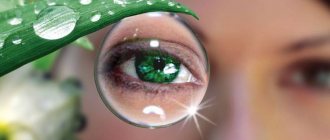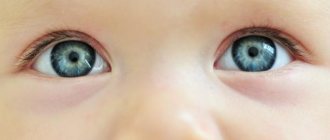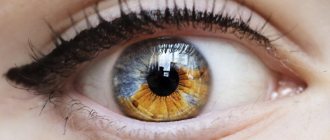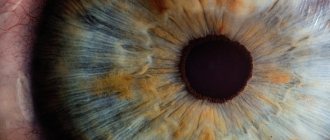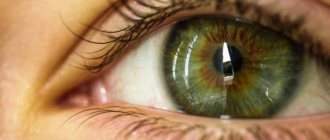Even when the child is in the womb, his parents try to guess who he will be like. And with the birth of the baby, not only mom and dad, but all relatives begin to compare the appearance and color of the baby’s eyes, arguing among themselves: “Mom’s nose!”, “But daddy’s eyes!”, forgetting that the baby’s facial features will change over time. . This especially applies to the color of the iris, which changes with age in most children. What exactly do such changes depend on? Why is this happening? When is the final color formed? We will tell you about all the features of eye color in this article.
The main factors influencing eye color
- Amount of pigment. All babies are born with gray-blue or greenish eyes, since there is no melanin pigment in the iris of a newborn. But gradually it accumulates, and the color of the baby’s eyes begins to change. The shade of the iris depends on the amount of this pigment substance: the more of it in the body, the darker the color. Melanin acts in the same way on human skin and hair.
- Nationality. Belonging to one's people is directly related to the color of one's skin, eyes and hair. For example, the vast majority of Europeans have gray, blue and light blue eyes, while Mongols and Turks have green, light brown and greenish-brown eyes. The Slavs have light blue and light gray eyes, the Negroid race has dark brown and black eyes. Of course, there are exceptions, but this is most likely the result of mixed marriages.
- Genetics. Related genes play a significant role in how a child will be born and who he will resemble. But you can’t rely 100% on genetics. If mom and dad have light eyes, then the likelihood that the baby will also have light eyes is 75%. If mom has light eyes and dad has dark eyes (and vice versa), then the baby will most likely have a dark color. If both parents have dark eyes, then the baby is unlikely to have a light color.
What color are children's eyes at birth?
The color of the iris depends on melanin, a protein secreted by special cells called melanocytes that also affect skin color. If a baby’s heredity is dominated by a trait such as dark skin, then his eyes at birth will most likely be brown. And Caucasian babies are usually born with blue or gray eyes.
Melanocytes release pigment in response to light. Since the baby is in the dark before birth, at birth the concentration of pigment is extremely low and the eye color of newborns is often blue or gray. Over time (sometimes over several years) eye color will change when exposed to light.
If the level of melanin (color pigment) increases slightly after birth, then the baby may remain blue-eyed. A little more melanin - the eyes become green or marshy (another similar shade is called hazel, green-brown, olive). Brown eyes are the result of active melanin production. Brown eyes usually maintain their color throughout life.
When does a baby's eye color start to change?
From the moment a baby is born, his eye color remains a dull gray or greenish color for some time. But after six months, the shade of the iris begins to gradually change. And since changes occur slowly, the results are almost invisible to us. Due to melanin staining, a newborn’s eyes first darken, and by six months or one year of age they acquire the shade determined by genes. But this is not the final result. Melanin continues to accumulate and the color will take several years to form. It will become final by the age of 5-10 - this is individual for each child. In any case, the future color of the baby’s eyes can be judged no earlier than six months, and only at one year will it become clear what shade of eye color the child will have.
How to determine eye color in newborns, table
You can determine what eye color your baby will be born with using the table. But it is impossible to speak with certainty about the color of the iris. The genes of grandparents, uncles or aunts can play a role in the formation of shade. Although the determining factor when laying eye color remains parental genes
The color of a child's eyes can be predicted using a special online program. You just need to indicate the color of the iris of mom and dad and their parents. The program displays the most likely option
Can eye color remain the same or change?
- Grey. This color occurs quite often at the birth of a child and can vary from a light tone to a dark shade. Most often, babies with gray eyes appear among northeastern peoples. This color is typical for calm and slow children.
- Blue. The beautiful heavenly shade can also either lighten or darken over time, especially if the baby is fair-haired and fair-skinned. Children with blue eyes are dreamers, they are not capricious, prone to sentimentality and even pragmatic.
- Blue. This color is often found among northern peoples; the blue tint is formed as a result of a large amount of pigment that has already been produced in the body. Kids with blue eyes are vulnerable, touchy and emotional.
- Green. Children with green irises are born only to parents with light eyes. According to statistics, residents of Iceland and Turkey have the most green-eyed children. These kids are very demanding, persistent and stubborn - real leaders!
- Brown. If a baby is genetically programmed to have brown eyes, he will be born with a dark gray iris, which will change its shade to a brown tone closer to six months. Such children are distinguished by excessive activity, a cheerful disposition, shyness and hard work.
Genetic characteristics of eye color
The color of a child’s eyes is one of the inherited characteristics that makes him similar to his father, mother or close relatives, which are grandparents.
In the laws of genetics, there are two concepts - dominance and recessivity. The dominant trait is always stronger; in a child it suppresses the weaker one - the recessive one, but does not block it completely, allowing it to manifest itself in the next generation.
Brown eye color always prevails over green, green over gray and blue. However, if the baby has a blue-eyed grandfather or a gray-eyed grandmother, then the eyes may be blue or gray. This means that the trait is passed on through generations.
It must be remembered that the laws of heredity are much more complex than those that we study at school.
Thus, scientists have found that sections of six genes affect the color of a child’s iris, so there are thousands of variations of just shades of the same eye color. In addition to the classical rules of genetics, there are mutations, an example of which is purple eye color.
In what cases can there be eyes of different colors?
Very rarely there are pathologies of eye color that distinguish us from other people. They appear from birth and are visible almost immediately.
- Albinism. In this case, we are talking about the complete absence of the melanin pigment, as a result of which the eyes acquire a red tint. The main reason lies in the fact that the vessels of the iris are visualized. This pathology is very rare in humans.
- Aniridia. This is also a congenital anomaly, which is characterized by the absence of the iris, complete or partial, which directly affects vision. In most cases, this is inherited, and visual acuity is quite low.
- Heterochromia. Another hereditary pathology is when the eyes are of different colors. A child may have one eye brown and the other gray or blue. But there may be other options. This mutation does not affect vision or other functions in any way.
What color will your baby's eyes be?
Eye color is a hereditary trait and is determined primarily by one chromosome containing two genes. One determines the level of melanin in the iris, the other controls the activity of melanocytes. These two genes play a major role in the formation of eye color. Other genes are also involved in this process, but their role is less significant.
It is impossible to accurately predict a child's eye color based on the parents' eye color. Although in some cases genetics may play along with you and your expectations will be confirmed.
Here are some likely patterns when it comes to baby's eye color:
- If both parents have blue eyes, then there is a high probability that the child will also have blue eyes.
- If both parents have brown eyes, then there is a high probability that the child will also have brown eyes.
- If one of your grandparents has blue eyes, your baby is more likely to have blue eyes.
- If one parent has blue eyes and the other has brown eyes, then the child has a 50/50 chance of having brown or blue eyes.
WIDER POWER
- Eye color is usually fully developed by the end of the first year of life, but color changes slow down after the baby is six months old. For some children, the color may continue to change for several years.
- No. Often, Caucasian children have gray or blue eyes at birth due to a lack of pigment. Later, upon contact with light, the color of the eyes begins to change. Children with dark skin are most often born with brown eyes.
- Eye color is a hereditary trait and is determined primarily by one chromosome containing two genes. One determines the level of melanin in the iris, the other controls the activity of melanocytes. These two genes play a major role in the formation of eye color.
- At birth, a baby's eye color may be gray or blue due to a lack of pigment. When exposed to light, most often the eye color begins to change towards rich blue, green, marsh or brown. Changes occur over a period of six months to a year.
Your baby's eye color is as unique as the baby itself. And no matter what the color ends up being, looking into those eyes is happiness! We hope you enjoyed reading what affects a child's eye color. Very soon you will find out what your child's permanent eye color will be - just one of many unique appearance and character traits that will gradually appear before your eyes.
Do diseases affect changes in eye color?
Previously, it was believed that if the shade of the iris changed, this certainly indicated that a person had some kind of disease. But research has refuted this theory. However, there are diseases that actually change eye color.
- Wilson-Konovalov disease. This disease can be diagnosed in young children and is a metabolic disorder that affects the nervous system. As a result, the ring around the iris of the eye becomes pronounced and distinct.
- Diabetes. Eye color can change only if the disease is severe - the iris becomes red-pink. The reason is the formation of blood vessels that appear during the disease. But this does not affect visual acuity in any way.
- Melanoma. Any tumor provokes changes in the body, and eye color is no exception. If this disease is diagnosed, the eye color may change to a darker shade. For example, blue eyes can become almost blue.
- Anemia. When the body lacks iron, it affects many organs. It often happens that the eye color becomes a shade (or even two) lighter. For example, blue eyes can turn blue, and black eyes can change to a brown tone.
Can diseases change eye color?
In a number of diseases, the iris can change its color:
- with uveitis, it becomes red due to stagnation of blood in the vessels;
- in severe cases of diabetes mellitus – red-pink due to the appearance of newly formed vessels;
- in the case of Wilson-Konovalov disease, a ring is formed around the iris due to copper deposits;
- sometimes not the color, but the shade may change, becoming darker (with siderosis or melanoma) or lighter (with leukemia or anemia).
Changes in eye color appear at the height of the disease, when the clinical picture and the main symptom complex do not cast doubt on the diagnosis.
At the end of the last century, the method of iridology was very popular. Changes in the pattern, color and structure of the iris were studied.
It was believed that it was possible to diagnose almost all diseases occurring in the human body. Within the framework of evidence-based medicine, this method turned out to be absolutely unreliable, and therefore is not used today.
Changing the color or shade of the eyes is a matter of time. You shouldn’t waste such short days waiting for small changes. After all, we love a baby not for external signs, but for what he is!
Does eye color affect visual acuity?
It is unknown where these assumptions came from, but for some reason many people believe that eye color is directly related to vision. Does the color of the iris really have any effect on dioptres? No evidence has been found for this. Any baby sees much weaker than an adult - this is explained by the fact that not all the organs of a newborn are sufficiently formed. Moreover: in the very first days of his life, the baby does not see anything at all, he only reacts to light. And only by a month or two or three he can already distinguish objects by 50%, after which his vision gradually becomes sharper.
Time frame for final determination of eye color
The shade of light eyes, even of adults, often changes depending on a person’s mood: they can lighten and darken within the same color range, when he is happy or angry. The same thing happens in babies: if a baby is hungry, his eyes turn grey, when he cries, they turn green, when he wants to sleep, they become covered with a slight cloudiness, and if everything is fine, they will be sky blue.
But the color of children's eyes can become different not only from their emotional state. Gradually, as melatonin levels increase, newborns' eyes change - often more than once until they regain their true color. They can turn gray, lighten, darken, and turn blue again - depending on fluctuations in the pigment content in the body. These changes are superficial and do not in any way affect the structure of the eye itself, that is, they cannot harm the baby’s vision in any way.
There are no strict limits on how long it should take for a child to finally change their eye color. Some people produce melanin quickly enough, and by 3 months they acquire their real eye color. Thus, in newborns with genetically determined brown eyes, the pigment is produced faster, and by the above period, their eyes actually acquire the color inherited from their parents.
In other newborns, the eyes can change their color 3-4 times until they reach the genetically determined shade. This happens due to fluctuations in melanin production and does not pose any danger to the child’s vision.
Most often, the eye color of newborns finally changes by 6-9 months; during this period, the production of melanin in the child’s body is especially high. But there are children who, up to 3-4 years old, retain the eye color given by nature at birth. This is considered the norm.
Sooner or later, a change in eye color in a child will occur if there are hereditary prerequisites for this. A slight delay in timing does not indicate any deviations if the iris is evenly colored and the same color in both eyes.
What else affects the color of a baby’s iris?
Don’t be alarmed if you suddenly notice that the color of your baby’s eyes has become lighter or darker. Babies, like adults, react to external stimuli, which affects the shade of their iris. For example, if the baby’s gray eyes have brightened, this indicates that the child may be reacting this way to the weather (for example, bright sun or rain). If the color of the eyes has darkened, then it is possible that the baby is in pain. It also happens that the shade of a baby’s iris can become almost transparent - do not be alarmed by this. Your baby is simply calm, peaceful and in a relaxed state.
Approximate dates
Since heredity is a mysterious matter, it is almost impossible to determine the timing for each specific child.
There are data based on long-term observations of infants that are roughly worth focusing on.
So, in the first three months of a baby's life, the color of his eyes may remain uncertain, that is, you will not even understand what to expect in the future. However, soon it will definitely begin to change. When this happens is determined individually, so you shouldn’t look at your neighbor’s kids and compare.
The child's first year will be full of surprises for parents when it comes to eye color. They will either darken or lighten, depending on the amount of melanin. For some children, this process ends quite quickly, while for others it can take several years.
How much exactly? Again, this is a matter of heredity, so it is impossible to set exact dates. There are cases where the final eye color was established only by the age of 4.
It is noteworthy that in fair-haired babies, the eyes change color especially intensively, and they can easily turn from light blue to quite dark, brown, green, gray.
Usually by six months it becomes approximately clear what the main color will be. With dark-skinned children the situation is simpler. In most cases, the eyes turn out to be brown when the shade stops changing.
